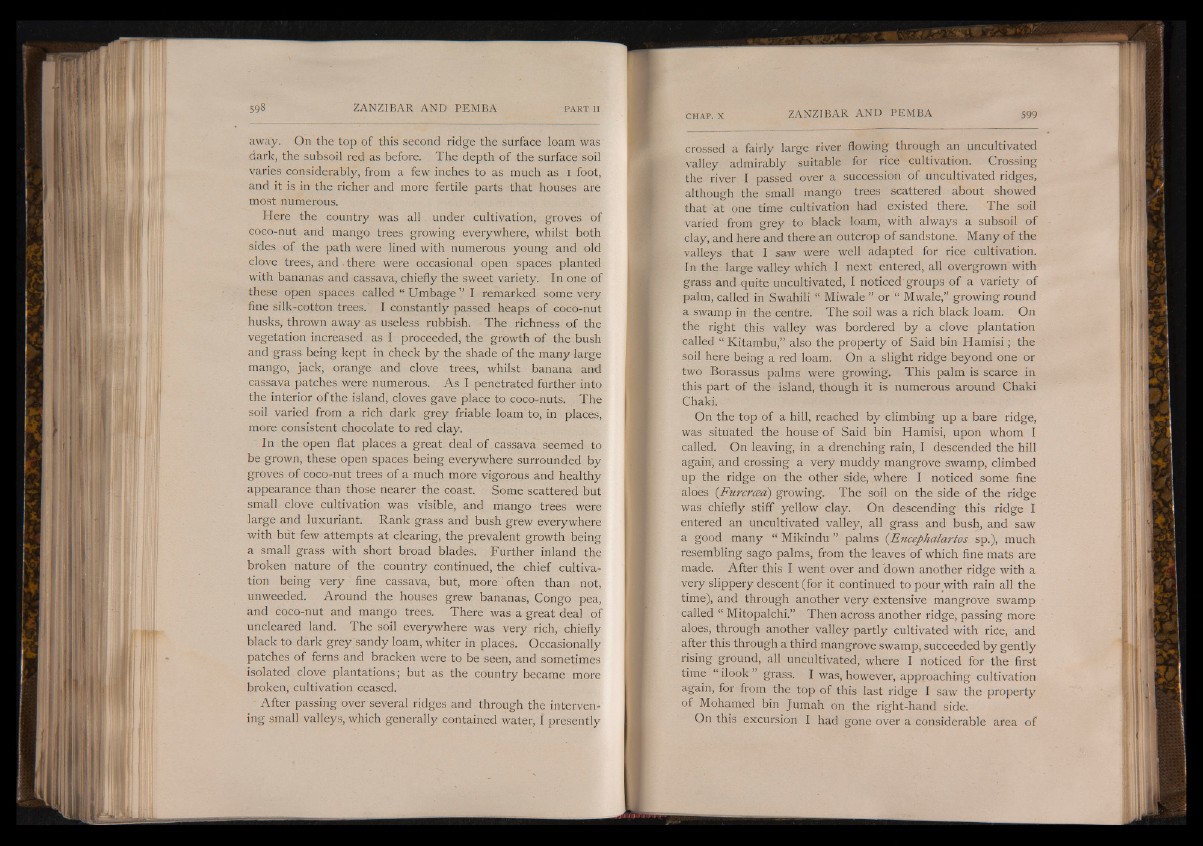
away. On the top of this second ridge the surface loam was
dark, the subsoil red as before. The depth of the surface soil
varies considerably, from a few inches to as much as i foot,
and it is in the richer and more fertile parts that houses are
most numerous.
Here the country was all under cultivation, groves of
coco-nut and mango trees growing everywhere, whilst both
sides of the path were lined with numerous young and old
clove trees, and. there were occasional open spaces planted
with bananas and cassava, chiefly the sweet variety. In one of
these open spaces called “ Umbage I I remarked some very
fine silk-cotton trees. I constantly passed heaps of coco-nut
husks, thrown a way-as useless rubbish. The richness of the
vegetation increased as I proceeded, the growth of the bush
and grass being kept in check by the shade of the many large
mango, jack, orange and clove trees, whilst banana and
cassava patches were numerous. As I penetrated further into
the interior of the island, cloves gave place to coco-nuts. The
soil varied from a rich dark grey friable loam to, in places,
more consistent chocolate to red clay.
In the open flat places a great deal of cassava seemed to
be grown, these open spaces being everywhere surrounded by
groves of Coco-nut trees of a much more vigorous and healthy
appearance than those nearer the coast. Some scattered but
small clove cultivation was visible, and mango trees were
large and luxuriant. Rank grass and bush grew everywhere
with but few attempts at clearing, the prevalent growth being
a small grass with short broad blades. Further inland the
broken nature of the country continued, the chief cultivation
being very fine cassava, but, more dften than not,
unweeded. Around the houses grew bananas, Congo pea,
and coco-nut and mango trees. There was a great deal of
uncleared land. The soil everywhere was very rich, chiefly
black to dark grey sandy loam, whiter in places. Occasionally
patches of ferns and bracken were to be seen, and sometimes
isolated clove plantations; but as the country became more
broken, cultivation ceased.
• After passing over several ridges and through the intervening
small valleys, which generally contained water, I presently
crossed a fairly large river flowing through an uncultivated
valley admirably suitable for rice cultivation. Crossing
the river I passed over a succession of uncultivated ridges,
although the small mango trees scattered about showed
that at one time cultivation had existed there. The soil
varied from grey to black loam, with always a subsoil of
clay, and here and there an outcrop of sandstone. Many of the
valleys that I saw were well adapted for rice cultivation.
In the large valley which I next entered, all overgrown with
grass and quite uncultivated, I noticed' groups of a variety of
palm, called in Swahili 1 Miwale ” or “ Mwale,” growing round
a swamp in the centre. The soil was a rich black loam. On
the right this valley was bordered by a clove plantation
called “ Kitambu,” also the property of Said bin Hamisi; the
soil here being a red loam. On a slight ridge beyond one or
two Borassus palms were growing. This palm is scarce in
this part of the island, though it is numerous around Chaki
Chaki.
On the top of a hill, reached by climbing up a bare ridge,
was situated the house of Said bin Hamisi, upon whom I
called. On leaving, in a drenching rain, I descended the hill
again, and crossing a very muddy mangrove swamp, climbed
up the ridge on the other side, where I noticed some fine
aloes (Furcrcea) growing. The soil on the side of the ridge
was chiefly stiff yellow clay. On descending this ridge I
entered an uncultivated valley, all grass and bush, and saw
a good many “ Mikindu ” palms (Encephalartos sp.), much
resembling sago palms, from the leaves of which fine mats are
made. After this I went over and down another ridge with a
very slippery descent (for it continued to pour with rain all the
time), and through another very extensive mangrove swamp
called “ Mitopalchi.” Then across another ridge, passing more
aloes, through another valley partly cultivated with rice, and
after this through a third mangrove swamp, succeeded by gently
rising ground, all uncultivated, where I noticed for the first
time “ ilook ’ grass. I was, however, approaching cultivation
again, for from the top of this last ridge I saw the property
of Mohamed bin Jumah on the right-hand side.
On this excursion I had gone over a considerable area of